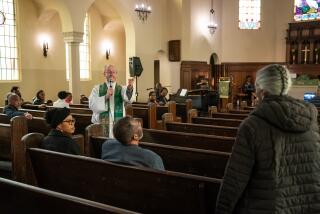The MIDI can record any sound and play it back on Sunday.
- Share via
After waiting 40 years, a Glendale church finally got a real organ Sunday.
In a way, it was more than real. It is an unusual instrument that speaks at once with the mysterious textures of a 500-year-old craft and with the technological power of a modern computer.
St. Matthew’s Lutheran Church, on the west end of Glenoaks Avenue, has had three organs before this, none quite the perfect instrument.
As told in a history of St. Matthew’s organs, published for the 350 parishioners who attended Sunday’s dedication concert, the path to musical perfection has been arduous.
When the church was new, in 1948, a member of the congregation donated its first instrument, a foot-pumped reed organ. It served until 1954, when the congregation put together a fund to buy a used Baldwin electronic for $2,200.
The reed hadn’t finished its duty, however, just because it was replaced. At the request of the family that donated it, the reed went on to a another assignment with St. Stephen of the Valley, a new congregation in Palmdale, whose pastor came to pick it up in a trailer.
Later, St. Stephen built a sanctuary and installed another organ. An agricultural missionary who was passing through said he could place the reed somewhere else. And so, it is now the organ of the Lutheran Church of Tanzania.
The Baldwin, meanwhile, was getting cranky by the late 1960s. The congregation began its second organ fund. It grew to $4,800 in three years. On the first Sunday of Lent in 1971, the three-manual Rogers electronic organ made its debut. The Baldwin found its way to the parish hall.
Still, the history said, “the dream of a pipe organ for the church persisted.”
The dream had begun in 1962. In that year, the existing sanctuary--a lean, bright, masonry-and-stained glass hall--was completed. The architect included a platform for organ pipes behind the choir’s three pews on the balcony.
Then, the subject lay dormant for another quarter century until parishioner Judy Carlson Dellinger spoke up at a Sunday luncheon in 1985.
“How do we get a pipe organ fund started?” she asked, according to the history.
“Give me a check and it will begin,” Pastor Dwight Johnson replied.
The history then noted that “a rush of check writing began.”
The rest of the organ’s story took shape from the musical traditions that were already developing, along with the congregation’s two very different organists.
Frank Fetta, a young man with a taste for Melrose Avenue fashions, launched a whirlwind musical career while he was playing organ on Sundays at St. Matthew’s. Fetta has conducted the San Diego Opera, the Utah Opera, the Pasadena Symphony, Opera a La Carte, and a few others. He is now artistic director-conductor of the Marina Del Rey-Westchester Symphony. His music, like his clothes, ventures toward the mod and experimental.
Robert Tall, stiff in his formality, is an organist through and through. His mother played the Wurlitzer in silent movies. He’s been a guest performer at the Mormon Tabernacle and is the featured organist at the Easter unrise service in the Hollywood Bowl.
He is also the Southern California representative of Rodgers Organ Co. of Hillsboro, Ore.
That company is doing something new with church organs. It is taking real organ pipes from Holland--hand-soldered from nickel, tin and copper--and putting them together with microchip processors from Silicon Valley.
The combination would make it possible to fill the small balcony with a selection of the best-sounding windpipes and add a speaker system that would give an approximation of the Mormon Tabernacle.
The heart of the system is called a MIDI--Musical Instrument Digital Interface. Among its many wonders, it can record any real musical sound in digital language and play it back on Sunday.
While they may not have understood the language, parishioners clearly understood the benefit of bringing all the repertory of polyphonic music into their small sanctuary.
Within just a year, the congregation had paid for a $125,000 instrument and almost that much again for structural preparations, Johnson said.
Last week, technicians put the last of the pipes in place and tuned the pipes, using fine hand tools to bend pipe tongues into perfect pitch.
The organ came with two traditional consoles, each having three keyboards, pedals and lighted knobs to push and pull.
Because the opportunity was there, the committee also bought two Yamaha DX 7 synthesizers. They hook into the consoles and can give the instrument the flexibility of four organists playing at once, or two organists and a chamber orchestra and choir.
“For a small church, this gives us capacities,” Johnson said, almost at a loss for words to describe its power.
It would even allow the organist to sub for the church tenor, if he had an accident on the way to church.
“It just blows your mind,” Johnson said. “You haven’t got any tenor. But you can hear a tenor sure and clear.”
And now, with the excitement over, maybe Fetta and Tall can get into some serious liturgical improvisation.
More to Read
The biggest entertainment stories
Get our big stories about Hollywood, film, television, music, arts, culture and more right in your inbox as soon as they publish.
You may occasionally receive promotional content from the Los Angeles Times.











